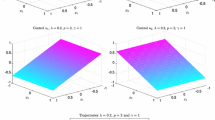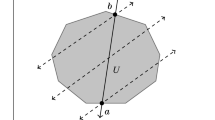Abstract
In this work, we address the fundamental problem of steering the state of a discrete-time linear system to the origin after a given (finite) number of stages by means of the sparsest possible control sequence, that is, the sequence of inputs comprised of the maximum possible number of null elements. In our approach, the latter controllability problem is associated with the problem of finding either the minimum 1-norm solution or the minimum p-norm, with p taking values greater than zero and less than one, solution of an under-determined system of linear equations, which are both known to exhibit good sparsity properties under certain technical assumptions. Motivated by practical considerations, we compute approximate solutions to the latter optimization problems by utilizing the class of iteratively weighted least squares algorithms from the literature of compressive (or compressed) sensing. This particular choice of algorithms is motivated by (1) their straightforward implementation, which makes them appealing to the non-expert and (2) the fact that some of the most costly operations involved in their implementation can be carried out recursively by leveraging well-known properties of the controllability Grammian of a discrete-time linear system. Finally, we apply the proposed approach to a spacecraft proximity operation problem and in particular, a linearized impulsive fixed-time minimum-fuel rendezvous problem in which the 1-norm serves as a proxy to the fuel consumption at a given time interval.





Similar content being viewed by others
Notes
Here the \(\ell _0\)-norm of a control sequence is taken to be the 0-norm of the vector that results from concatenating the vectors of the sequence. The 0-norm of a vector is in turn defined as the number of its nonzero elements.
Strictly speaking, when \(p\in [0,1[\), both the p-norm and the \(\ell _p\)-norm are not norms in the strict mathematical sense.
References
Foucart, S., Rauhut, H.: A Mathematical Introduction to Compressive Sensing. Birkhauser, Basel (2013)
Liu, R.R., Golovitcher, I.M.: Energy-efficient operation of rail vehicles. Transp. Res. Part A Policy Pract. 37(10), 917–932 (2003). https://doi.org/10.1016/j.tra.2003.07.001
Nagahara, M., Quevedo, D.E., Nesic, D.: Maximum hands-off control: a paradigm of control effort minimization. IEEE Trans. Autom. Control 61(3), 735–747 (2016). https://doi.org/10.1109/TAC.2015.2452831
Aguilera, R.P., Urrutia, G., Delgado, R.A., Dolz, D., Aguero, J.C.: Quadratic model predictive control including input cardinality constraints. IEEE Trans. Autom. Control 62(6), 3068–3075 (2017). https://doi.org/10.1109/TAC.2017.2674185
Lyu, Q., Lin, Z., She, Y., Zhang, C.: A comparison of typical \(\ell _p\) minimization algorithms. Neurocomputing 119(11), 413–424 (2013). https://doi.org/10.1016/j.neucom.2013.03.017
Daubechies, I., DeVore, R., Fornasier, M., Gunturk, C.S.: Iteratively reweighted least squares minimization for sparse recovery. Commun. Pure Appl. Math. 63(1), 1–38 (2010). https://doi.org/10.1002/cpa.20303
Candes, E.J., Tao, T.: Decoding by linear programming. IEEE Trans. Inf. Theory 51(12), 4203–4215 (2005). https://doi.org/10.1109/TIT.2005.858979
Handelsman, M., Lion, P.M.: Primer vector on fixed-time impulsive trajectories. AIAA J. 6(1), 127–132 (1968). https://doi.org/10.2514/3.4452
Prussing, J.E.: Optimal four-impulse fixed-time rendezvous in the vicinity of a circular orbit. AIAA J. 7(5), 928–935 (1969)
Carter, T.E., Brient, J.: Linearized impulsive rendezvous problem. J. Optim. Theory Appl. 86(3), 553–584 (1995)
Arzelier, D., Louembet, C., Rondepierre, A., Kara-Zaitri, M.: A new mixed iterative algorithm to solve the fuel-optimal linear impulsive rendezvous problem. J. Optim. Theory Appl. 159(1), 210–230 (2013)
Claeys, M., Arzelier, D., Henrion, D., Lasserre, J.: Moment LMI approach to LTV impulsive control. In: 52nd IEEE Conference on Decision and Control, pp. 5810–5815 (2013)
Arzelier, D., Berhard, F., Deak, N., Joldes, M., Louembet, C., Rondepierre, A., Serra, R.: Linearized impulsive fixed-time fuel-optimal space rendezvous: a new numerical approach. In: 20th IFAC Symposium on Automatic Control in AerospaceACA 2016, vol. 49, pp. 373–378 (2016). https://doi.org/10.1016/j.ifacol.2016.09.064
Neustadt, L.: Optimization, a moment problem, and nonlinear programming. J. Soc. Ind. Appl. Math. Ser. A Control 2(1), 33–53 (1964). https://doi.org/10.1137/0302004
Nagahara, M., Ostergaard, J., Quevedo, D.E.: Discrete-time hands-off control by sparse optimization. EURASIP J. Adv. Signal Process. 76, 1–8 (2016)
Bakolas, E.: Solution to the minimum \(\ell _1\)-norm controllability problem for discrete-time linear systems via iteratively reweighted least squares. In: American Control Conference, pp. 1244–1249 (2018)
Calafiore, G., El Ghaoui, L.: Optimization Models. Cambridge University Press, Cambridge (2014)
Antsaklis, P., Michel, A.N.: Linear Systems. Birkhauser, Boston (2005)
d’Aspremont, A., El Ghaoui, L.: Testing the nullspace property using semidefinite programming. Math. Progr. 127(1), 123–144 (2010). (Special issue on machine learning)
Clohessy, W.H., Wiltshire, R.S.: Terminal guidance for satellite rendezvous. J. Aerosp. Sci. 27, 653–658 (1960)
Asif, M.S., Romberg, J.: Sparse recovery of streaming signals using L1-homotopy. IEEE Trans. Signal Process. 62(16), 4209–4223 (2014). https://doi.org/10.1109/TSP.2014.2328981
Author information
Authors and Affiliations
Corresponding author
Additional information
Communicated by Martin Corless.
Publisher's Note
Springer Nature remains neutral with regard to jurisdictional claims in published maps and institutional affiliations.
Rights and permissions
About this article
Cite this article
Bakolas, E. On the Computation of Sparse Solutions to the Controllability Problem for Discrete-Time Linear Systems. J Optim Theory Appl 183, 292–316 (2019). https://doi.org/10.1007/s10957-019-01532-9
Received:
Accepted:
Published:
Issue Date:
DOI: https://doi.org/10.1007/s10957-019-01532-9
Keywords
- Sparse control
- Iterative least squares algorithm
- Discrete-time linear systems
- Compressive sensing
- Linearized impulsive minimum fuel control




